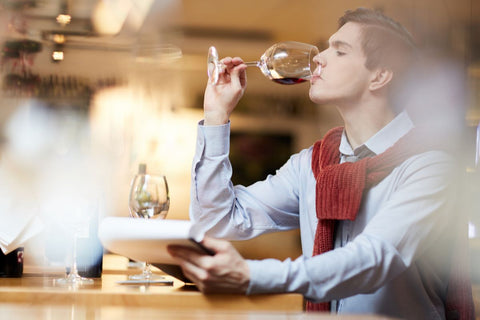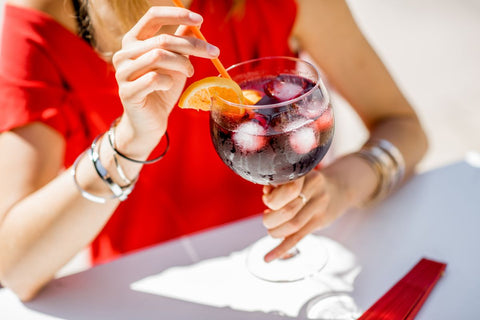What tips should I follow to taste red wine?
- Prepare what you need for wine tasting
- Check the appearance
- Give a swirl, and smell your wine
- Pay attention to smell
- Take a sip and taste
- Put it all together
Though it's fun to drink red wine with meals, with friends, or purely for pleasure without any concern for technique or method, you’re probably not experiencing your wine to its fullest.
That said, if you want to get as much out of your bottle of wine as possible, then you have to know how to taste red wine. In this simple guide, we cover some tasting tips — practiced by even expert sommeliers — to help you sharpen your senses, refine your palate, and better taste that bottle of red wine you just opened.
Prepare what you need for wine tasting

Before you start tasting, you need some preparation. First, you need the right wine glass (we show you how to pick one here), and a white tablecloth or paper for a neutral backdrop. We recommend doing your tasting somewhere brightly lit with natural light, and away from strong smells like cooking oil, perfumes, and the like.
You can also prepare a way to work methodically and take notes on your red wine. This is a great way to track your observations and build your flavor vocabulary. You can also refer to flavor wheels like this to understand the different terms we use.
The red wine itself should be served at the correct temperature, which is typically 12 to 18℃ for reds. Serving it too cold will make the flavors and smells more muted, and serving it too warm will make it taste overly alcoholic. Wine pros use something called the 20/20 rule — where you put your red wine in the fridge for at least 20 minutes before serving.
Check the appearance
Now you can pour some of your red wine. Don’t fill up the glass, but try to have around a finger’s breadth of wine in the glass. Now, angle your glass and hold it above your neutral backdrop and check its appearance.
Some things to look for:
- How intense is the color? In red wines, this could be anything from a deep purple to a pale red.
- How does it look around the rim? Does the color fade, or turn orange or brown?
- Does the wine cling to the sides of the glass as you swirl it around? The trails it leaves are called “legs.”
- How clear is the wine? Does it appear slightly murky?
Appearance tells a lot about how the wine was made. For example, fading at the rim is a sign of age. A vivid purple suggests it's younger. Some grape varietals, like Malbec, can also produce a deep purple color. Legs, on the other hand, show how thick the wine is. Thickness is an indicator of high alcohol or residual sugar.
Give a swirl, and smell your wine

After checking the appearance, give it a little swirl. This aerates it and allows it to open up, releasing its smell. Put your nose near the rim of your glass and breathe in. Breathing in with an open mouth can help open up your olfactory system.
Breathe in gently and deeply, and keep an eye out for the following:
- Fruits — Think about what kind of fruit: dark, citrus, stone, tropical, or orchard? Try starting broadly, and move from there. Do the fruits smell fresh, jammy, or candy-like?
- Flowers — For example, lavender, honeysuckle, violets, elderflower, wildflowers.
- Spices — For example, vanilla, nutmeg, cinnamon, cloves, and pepper, are common in red wines.
- Toast and nuts — For example, walnuts, coconut, coffee, cocoa, brioche, and the like.
- Other smells: You might also pick up others like wood, cooked meat, tobacco, herbs, waxy, or stone-y scents.
While smelling, always remember to start broadly. Trying to start too specific can make things more difficult. You can divide the smell of a wine into three primary categories:
- Primary Aromas — These are typically the fruit and floral notes and are produced by the wine varietal.
- Secondary Aromas — Derived from the winemaking practices, and more pronounced in white wines than in red.
- Tertiary Aromas — Come from any aging process. Usually creates the spice, toast, and nut scents in wine.
The smell can tell you a lot about the climate, region, and methods in which the wine was made. For example, a rich and jammy fruit scent suggests a warm climate red wine. Aged wines also develop deeper flavors like tobacco and spices. It can even tell you how it was aged — oak-aged red wines often smell like nuts, cloves, vanilla, and coconut.
You can also detect any problems with the wine just from its scent. For example, if the cork was damaged and infected with fungus, then your red wine will smell damp and moldy.
Take a sip and taste
After smelling your wine, it's time to take a sip. Start small — avoid taking a big gulp. Hold this in your mouth and swirl it around a little. This helps your wine open up (much like swirling it around your glass).
Taste is an extension of smell, so most of the scents you noted before will connect to what you’ll taste. This will connect to the five tastes: sweet, bitter, salty, acidic, and umami. You might even notice a bit of grittiness and weight to the wine — which are created by the tannins in the wine.
So, there are many things to look for when you’re tasting your red wine, such as:
- Body — How thick, grainy, and chewy does it feel in your mouth?
- Sweetness — Can you feel the sweetness on your tongue, and how strong is it?
- Tannins — Does the wine taste ripe or green, or is there a sense of dryness and bitterness to it?
- Acidity — How fresh does the wine feel? Does it make your mouth water, or does it pass through smoothly?
- Warmth — Does your mouth feel warm after sipping on your wine?
- Finish — How long does the taste linger in your mouth after you have swallowed or spat out your red wine?
Like the smell, the taste gives insight as to how the red wine was made. Full-bodied wines tend to come from warm climates. They can also be produced by oak aging. Strong tannins can come from the varietal itself, but too-strong tannins come from poor production methods. Oak-barrel red wines also tend to create smoother-tasting tannins.
Sweetness is a sign that the wine is fortified, or made from late-harvest grapes. Other varieties have pronounced flavor characteristics. For example, Sangiovese wines lean towards bitterness, while Cabernet Sauvignons tend to be more acidic. Warmth is an indicator of high alcohol content, while a long finish is usually a sign that the grapes were packed full of flavor — suggesting a high-quality wine.
Put it all together
Now that you’ve noted the appearance, smell, and taste, it’s time to put everything together. Ask yourself:
- Did it taste balanced? Were several elements present and in harmonies, such as its fruit taste, acidity, and tannins? Unbalanced wines tend to feel like they lack something.
- How strong were the flavors and scents? Were you able to pick up distinct notes easily?
- How many different flavors and scents were there? Did it just taste of one thing, or were you able to find several in your red wine?
- Finally, your personal preference — did you enjoy your wine?
Develop a complete profile of the red wine you just tasted. This will serve as a reference if you decide to drink this red wine again. It can also help you develop your wine tasting abilities.



